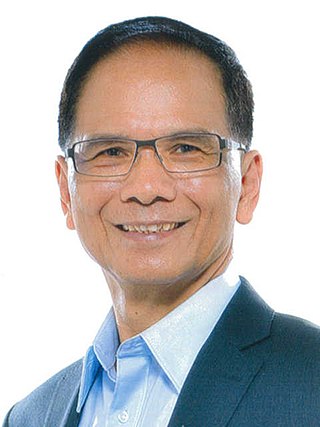Related Research Articles

The Democratic Progressive Party (DPP) is a Taiwanese nationalist and centre-left political party in the Republic of China (Taiwan). Currently controlling both the Republic of China presidency and the unicameral Legislative Yuan, it is the majority ruling party and the dominant party in the Pan-Green Coalition as of 2023.
The Republic of China, commonly known as Taiwan is governed in a framework of a representative democratic republic under a Five-Power system envisioned by Sun Yat-sen, whereby under the constitutional amendments, the President is head of state and the Premier is head of government, and of a multi-party system. Executive power is exercised by the government. Legislative power is vested in primarily with the parliament and limited by government. The Judiciary is independent of the executive and the legislature. In addition, the Civil service power is in charge of validating the qualification of civil servants and the supervision auditory power inspects, reviews, and audits the policies and operations of the government. The party system is dominated by the Kuomintang, which favors closer links to mainland China, and the Democratic Progressive Party, which favors Taiwanese nationalism.

The president of the Republic of China, now often referred to as the president of Taiwan, is the head of state of the Republic of China (ROC), as well as the commander-in-chief of the Republic of China Armed Forces. The position once had authority of ruling over Mainland China, but its remaining jurisdictions has been limited to Taiwan, Penghu, Kinmen, Matsu and other smaller islands since the conclusion of Second Chinese Civil War.

The Legislative Yuan is the unicameral legislature of the Republic of China (Taiwan) located in Taipei. The Legislative Yuan is composed of 113 members, who are directly elected for 4-year terms by people of the Taiwan Area through a parallel voting system.

The National Assembly was the authoritative legislative body of the Republic of China, commonly referred to as Taiwan after 1949, from 1947 to 2005. Along with the Control Yuan and the Legislative Yuan, the National Assembly formed the tricameral parliament of China. If still functional, at 3,045 members, the National Assembly would have been the largest parliamentary chamber in the world.

The Constitution of the Republic of China is the fifth and current constitution of the Republic of China (ROC), ratified by the Kuomintang during the Constituent National Assembly session on 25 December 1946, in Nanjing, and adopted on 25 December 1947. The constitution, along with its Additional Articles, remains effective in ROC-controlled territories.

The Control Yuan is the supervisory and auditory branch of the government of the Republic of China (Taiwan).
In Taiwan, parliamentary elections are held every four years to elect the 113 members of the Legislative Yuan, the unicameral legislature of Taiwan. The current electoral system was introduced in 2008. The constitutional amendments of 2005 extended term length from three to four years, reduced seat count from 225 to 113, and abolished the National Assembly, originally another governmental organ equivalent to a chamber of parliament.

An election for the National Assembly took place in Taiwan on Saturday, 14 May 2005, from 07:30 to 16:00 local time. It elected an ad hoc National Assembly whose only function was to serve as a constituent assembly in order to approve or reject amendments to the Constitution of the Republic of China already proposed by the Legislative Yuan. The results indicated that the amendments would be approved, as the parties supporting them won an overwhelming majority, and indeed the amendments were passed on 7 June 2005.

The president of the Legislative Yuan is the presiding officer of the Legislative Yuan of the Republic of China. The incumbent president is Yu Shyi-kun, a Democratic Progressive Party legislator and the second DPP President of the Legislative Yuan.

The 2008 Taiwanese legislative election was held on 12 January 2008 for members of the Legislative Yuan. It was the first Legislative Yuan election after the constitutional amendments of 2005, which extended term length from three to four years, reduced seat count from 225 to 113, and introduced the current electoral system.

The 1st Legislative Yuan election was held in China between 21 and 23 January 1948. This election, and the preceding 1947 National Assembly election are the first elections of under the newly ratified 1947 Constitution of the Republic of China. Under this constitution, the Legislative Yuan is a standing legislature when the National Assembly is not in session. At the time most of Chinese territory was under the control of the government of the Republic of China, using a direct voting system elected 759 Legislative Representatives. Using the Republic's then 461 million population to calculate, on average 600,000 people elected one representative in the Legislative Yuan. The election along with the one held for the National Assembly also made China the largest democracy at the time.
The first supplementary elections took place for the National Assembly and the Legislative Yuan in the Republic of China on 20 December 1969. Voter turnout was 54.7% and 55.0% respectively.
The third supplementary elections for the Legislative Yuan were held in the Republic of China (Taiwan) on 20 December 1975.
The fourth supplementary elections for the National Assembly and Legislative Yuan were held in the Republic of China (Taiwan) on 6 December 1980.
The fifth supplementary elections for the Legislative Yuan were held in the Republic of China (Taiwan) on 3 December 1983.
The sixth supplementary elections for the National Assembly and Legislative Yuan were held in Taiwan on 6 December 1986.
Legislative elections were held in Taiwan on 2 December 1989 to elect members of the Legislative Yuan.

Legislative elections were held in Taiwan on 19 December 1992.

The National People's Congress (NPC) is the national legislature and constitutionally the supreme state authority of the People's Republic of China.
References
- ↑ Dieter Nohlen, Florian Grotz & Christof Hartmann (2001) Elections in Asia: A data handbook, Volume II, p535 ISBN 0-19-924959-8
- 1 2 Dong, Xiangfei (1984). The General Conditions Regarding Elections in the Republic of China.